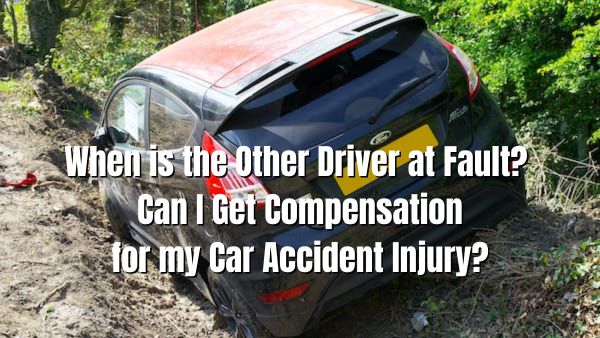When is the Other Driver at Fault? Can I Get Compensation for my Car Accident Injury?
Car accidents can be traumatic experiences, and when injuries are involved, the aftermath can be even more challenging. One of the critical aspects to consider in the aftermath of a car accident is determining fault. Understanding when the other driver is at fault and how you can seek compensation for your injuries is crucial for navigating the legal and insurance processes. In this article, we’ll explore the factors that determine fault, the process of seeking compensation, and the rights you have as an injured party.
Determining Fault in a Car Accident:
Determining fault in a car accident is essential for assigning responsibility and liability. Several factors are considered when establishing fault, including traffic laws, eyewitness accounts, and available evidence such as photographs and police reports. While each accident is unique, there are common scenarios where the other driver may be at fault:
- Traffic Violations: If the other driver violated traffic laws, such as running a red light, speeding, or failing to yield, they may be considered at fault for the accident. Traffic violations are clear indicators of negligence and can significantly impact the allocation of fault.
- Distracted Driving: Distracted driving, often involving activities like texting or talking on the phone while driving, is a prevalent cause of accidents. If the other driver was distracted at the time of the collision, they may be held responsible for the accident.
- Drunk Driving: Driving under the influence of alcohol or drugs is not only illegal but also a major factor in many accidents. If the other driver was impaired at the time of the crash, they are likely to be considered at fault.
- Failure to Follow Road Signs: Ignoring road signs and signals can lead to accidents. If the other driver failed to adhere to posted signs, such as stop signs or yield signs, they may be deemed at fault for the collision.
- Unsafe Lane Changes: Making unsafe lane changes, such as not signaling or failing to check blind spots, can result in accidents. If the other driver’s negligence in changing lanes caused the collision, they may be held responsible.

Compensation for Car Accident Injury:
Once fault is established, the next step is seeking compensation for your injuries. Compensation may cover medical expenses, lost wages, pain and suffering, and property damage. Here’s a step-by-step guide to help you navigate the process:
- Seek Medical Attention: Your health should be your top priority. Seek medical attention immediately, even if your injuries seem minor. Medical records will play a crucial role in establishing the extent of your injuries and the necessary compensation.
- Document the Scene: If you can, document the accident scene by taking photographs. Capture the position of vehicles, damages, road conditions, and any relevant signage. This documentation can serve as valuable evidence when determining fault.
- Collect Information: Obtain the contact information of the other driver, any witnesses, and law enforcement officers present at the scene. Having this information will be beneficial during the insurance claim process.
- Notify Your Insurance Company: Report the accident to your insurance company promptly. Provide them with all the details and documentation you have gathered. Be honest and accurate in your account of the events leading to the accident.
- Consult an Attorney: If you sustained injuries and believe the other driver is at fault, consider consulting a personal injury attorney. An experienced attorney can guide you through the legal process, help assess the value of your claim, and negotiate with insurance companies on your behalf.
- File a Personal Injury Claim: Depending on the severity of your injuries, you may need to file a personal injury claim against the at-fault driver’s insurance company. Your attorney can assist you in preparing and filing the necessary documents.
- Negotiate a Settlement: Insurance companies often try to settle claims quickly. However, the initial settlement offer may not fully cover your expenses. Your attorney can negotiate with the insurance company to ensure you receive fair compensation for your injuries.
- File a Lawsuit if Necessary: If negotiations do not result in a fair settlement, your attorney may recommend filing a lawsuit against the at-fault driver. Keep in mind that most personal injury cases are settled out of court, but being prepared to go to trial is essential.
Rights of Injured Parties:
As an injured party, you have rights that protect your interests in the aftermath of a car accident Injury:
- Right to Compensation: You have the right to seek compensation for your injuries if the other driver is determined to be at fault. This compensation aims to cover medical expenses, lost wages, and other damages resulting from the accident.
- Right to Legal Representation: You have the right to consult with and hire a personal injury attorney to represent your interests. An attorney can provide valuable guidance, ensuring that you navigate the legal process effectively.
- Right to Fair Treatment by Insurance Companies: Insurance companies are obligated to handle claims fairly and in good faith. If you believe you are not being treated fairly, you have the right to consult with an attorney and file a complaint with the appropriate regulatory authorities.
Conclusion:
Being involved in a car accident is a challenging experience, and seeking compensation for injuries adds another layer of complexity. Understanding when the other driver is at fault and knowing your rights in the aftermath of an accident is crucial. By following the steps outlined in this guide and seeking legal representation when necessary, you can navigate the process of obtaining compensation for your injuries with greater confidence and clarity. Remember, your well-being is paramount, so prioritize your health and seek the support you need to recover both physically and financially.
Insider Tips for a Successful Personal Injury Claim with Legal Representation